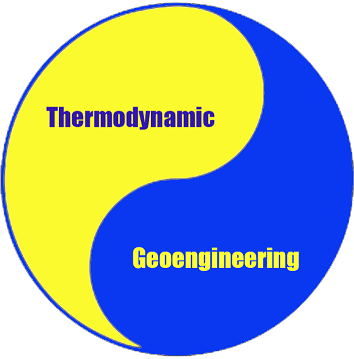| |
A Sustainable Blue Economy with Thermodynamic Geoengineering
and Biorock Technologies.
The Small Island Developing States or SIDS rebranded themselves a few years ago
as the Large Ocean Developing States on the basis of the 30 percent of the
global economic exclusion zones or EEZs they control.
For example Tuvalu, with a territorial land mass of 25.1 square kilometers,
has an Exclusive Economic Zone of 753,139 square kilometers. An economic
multiplier of 30,000 when this surface area is utilized to produce energy with
ocean thermal energy conversion.
And the 39 SIDS and 18 Associate Members of United Nations regional
commissions that face unique social, economic and environmental vulnerabilities
have similar potential with the same technology.
But not all ocean thermal energy conversion is created equally.
Typically, with conventional OTEC,
water is brought to the surface by massive pipes to condense a working fluid
after it has passed through a turbine to produce power after the working fluid
was first vaporized using surface heat.
The thermodynamic efficiency of this
process is only about 3 percent and the 97 percent of the surface heat diluted
by the cold water, is dispersed outward towards the poles that in the case of
the Artic is warmed 4 degrees over the course of 1,000 years at the same time as
the tropics are cooled by the same amount.
Instead of using an upwelling strategy,
Thermodynamic Geoengineering, doesn’t allow water to move between the thermal
layers of the ocean. It instead uses the phase changes of a working fluid to
move heat from the surface to a depth of 1000 meters, which provides 226 years
of global warming respite.
It also mitigates the two greatest
threat to island nations, sea level rise and storm surge.
This is because the coefficient of
expansion of sea water is half at 1000 meters it is at the surface, and heat
moved into deep water isn’t available to melt polar and Himalayan icecaps and
surface heat moved into deep water can’t power cyclones.
Using phase changes of a working fluid,
instead of with the sensible heat of water, heat is moved two and a half times
more efficiently with Thermodynamic Geoengineering than with conventional OTEC,
and accordingly Thermodynamic Geoengineering can produce two and half times
more energy as well.
At scale Thermodynamic Geoengineering
can produce over twice as much energy as is currently being derived from fossil
fuels.
From a depth of 1000 meters heat
diffuses back to the surface at a rate of 1 centimeter a day to the bottom of
the mixed layer, and 1 meter per day through that layer. So, it is back at
the surface in about 226 years where it can be recycled to produce more work.
Over the course of 13 cycles, all the
heat of warming can be converted to work and the waste heat of those conversions
can be dissipated back to space thus eliminating the problem of global warming.
An amalgam of the SIDS economic
exclusion zones with the economic and technical might of the Asia-Pacific
region are a recipe for a vibrant and prosperous sustainable blue economy that
can thrive on the cheapest energy that can be had with Thermodynamic
Geoengineering.
For more information please see
https://youtu.be/QxSXPulVyxU
.
Jim Baird <jim.baird@gwmitigation.com>
|
|
|
|
|
|



